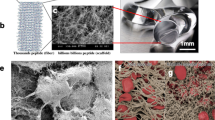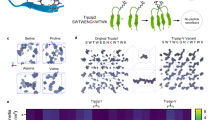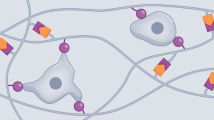Abstract
Biocompatible hydrogels have a wide variety of potential applications in biotechnology and medicine, such as the controlled delivery and release of cells, cosmetics and drugs, and as supports for cell growth and tissue engineering1. Rational peptide design and engineering are emerging as promising new routes to such functional biomaterials2,3,4. Here, we present the first examples of rationally designed and fully characterized self-assembling hydrogels based on standard linear peptides with purely α-helical structures, which we call hydrogelating self-assembling fibres (hSAFs). These form spanning networks of α-helical fibrils that interact to give self-supporting physical hydrogels of >99% water content. The peptide sequences can be engineered to alter the underlying mechanism of gelation and, consequently, the hydrogel properties. Interestingly, for example, those with hydrogen-bonded networks of fibrils melt on heating, whereas those formed through hydrophobic fibril–fibril interactions strengthen when warmed. The hSAFs are dual-peptide systems that gel only on mixing, which gives tight control over assembly5. These properties raise possibilities for using the hSAFs as substrates in cell culture. We have tested this in comparison with the widely used Matrigel substrate, and demonstrate that, like Matrigel, hSAFs support both growth and differentiation of rat adrenal pheochromocytoma cells for sustained periods in culture.
This is a preview of subscription content, access via your institution
Access options
Subscribe to this journal
Receive 12 print issues and online access
$259.00 per year
only $21.58 per issue
Buy this article
- Purchase on Springer Link
- Instant access to full article PDF
Prices may be subject to local taxes which are calculated during checkout




Similar content being viewed by others
References
Hirst, A. R., Escuder, B., Miravet, J. F. & Smith, D. K. High-tech applications of self-assembling supramolecular nanostructured gel-phase materials: From regenerative medicine to electronic devices. Angew. Chem. Int. Ed. 47, 8002–8018 (2008).
Woolfson, D. N. & Ryadnov, M. G. Peptide-based fibrous biomaterials: Some things old, new and borrowed. Curr. Opin. Chem. Biol. 10, 559–567 (2006).
Kopeček, J. & Yang, J. Y. Peptide-directed self-assembly of hydrogels. Acta Biomater. 5, 805–816 (2009).
Ulijn, R. V. & Smith, A. M. Designing peptide based nanomaterials. Chem. Soc. Rev. 37, 664–675 (2008).
Hirst, A. R. & Smith, D. K. Two-component gel-phase materials—highly tunable self-assembling systems. Chem. Eur. J. 11, 5496–5508 (2005).
Zhang, S. G., Holmes, T., Lockshin, C. & Rich, A. Spontaneous assembly of a self-complementary oligopeptide to form a stable macroscopic membrane. Proc. Natl Acad. Sci. USA 90, 3334–3338 (1993).
Aggeli, A. et al. Responsive gels formed by the spontaneous self-assembly of peptides into polymeric beta-sheet tapes. Nature 386, 259–262 (1997).
Pandya, M. J. et al. Sticky-end assembly of a designed peptide fiber provides insight into protein fibrillogenesis. Biochemistry 39, 8728–8734 (2000).
Hartgerink, J. D., Beniash, E. & Stupp, S. I. Self-assembly and mineralization of peptide-amphiphile nanofibers. Science 294, 1684–1688 (2001).
Schneider, J. P. et al. Responsive hydrogels from the intramolecular folding and self-assembly of a designed peptide. J. Am. Chem. Soc. 124, 15030–15037 (2002).
Paramonov, S., Gauba, V. & Hartgerink, J. Synthesis of collagen-like peptide polymers by native chemical ligation. Macromolecules 38, 7555–7561 (2005).
Petka, W. A., Harden, J. L., McGrath, K. P., Wirtz, D. & Tirrell, D. A. Reversible hydrogels from self-assembling artificial proteins. Science 281, 389–392 (1998).
Wang, C., Stewart, R. J. & Kopecek, J. Hybrid hydrogels assembled from synthetic polymers and coiled-coil protein domains. Nature 397, 417–420 (1999).
Potekhin, S. A. et al. De novo design of fibrils made of short alpha-helical coiled coil peptides. Chem. Biol. 8, 1025–1032 (2001).
Zimenkov, Y., Conticello, V. P., Guo, L. & Thiyagarajan, P. Rational design of a nanoscale helical scaffold derived from self-assembly of a dimeric coiled coil motif. Tetrahedron 60, 7237–7246 (2004).
Dong, H., Paramonov, S. E. & Hartgerink, J. D. Self-assembly of alpha-helical coiled coil nanofibers. J. Am. Chem. Soc. 130, 13691–13695 (2008).
Gribbon, C. et al. MagicWand: A single, designed peptide that assembles to stable, ordered alpha-helical fibers. Biochemistry 47, 10365–10371 (2008).
Ryadnov, M. G. & Woolfson, D. N. Engineering the morphology of a self-assembling protein fibre. Nature Mater. 2, 329–332 (2003).
Papapostolou, D. et al. Engineering nanoscale order into a designed protein fiber. Proc. Natl Acad. Sci. USA 104, 10853–10858 (2007).
Papapostolou, D., Bromley, E. H., Bano, C. & Woolfson, D. N. Electrostatic control of thickness and stiffness in a designed protein fiber. J. Am. Chem. Soc. 130, 5124–5130 (2008).
Blake, C. & Serpell, L. Synchrotron X-ray studies suggest that the core of the transthyretin amyloid fibril is a continuous beta-sheet helix. Structure 4, 989–998 (1996).
Perutz, M. F., Johnson, T., Suzuki, M. & Finch, J. T. Glutamine repeats as polar zippers—their possible role in inherited neurodegenerative diseases. Proc. Natl Acad. Sci. USA 91, 5355–5358 (1994).
Sikorski, P. & Atkins, E. New model for crystalline polyglutamine assemblies and their connection with amyloid fibrils. Biomacromolecules 6, 425–432 (2005).
Hamid, R., Rotshteyn, Y., Rabadi, L., Parikh, R. & Bullock, P. Comparison of alamar blue and MTT assays for high through-put screening. Toxicol. Vitro 18, 703–710 (2004).
Drubin, D. G., Feinstein, S. C., Shooter, E. M. & Kirschner, M. W. Nerve growth-factor induced neurite outgrowth in PC12 cells involves the coordinate induction of microtubule assembly and assembly-promoting factors. J. Cell Biol. 101, 1799–1807 (1985).
Debnath, J., Muthuswamy, S. K. & Brugge, J. S. Morphogenesis and oncogenesis of MCF-10A mammary epithelial acini grown in three-dimensional basement membrane cultures. Methods 30, 256–268 (2003).
Todoroki, S., Morooka, H., Yamaguchi, M., Tsujita, T. & Sumikawa, K. Ropivacaine inhibits neurite outgrowth in PC-12 cells. Anesth. Analg. 99, 828–832 (2004).
Pochan, D. J. et al. Thermally reversible hydrogels via intramolecular folding and consequent self-assembly of a de novo designed peptide. J. Am. Chem. Soc. 125, 11802–11803 (2003).
Winn, M. D. An overview of the CCP4 project in protein crystallography: An example of a collaborative project. J. Synchrotron. Radiat. 10, 23–25 (2003).
Makin, O. S., Sikorski, P. & Serpell, L. C. CLEARER: A new tool for the analysis of X-ray fibre diffraction patterns and diffraction simulation from atomic structural models. J. Appl. Crystallogr. 40, 966–972 (2007).
Acknowledgements
We are grateful to the BBSRC (IIP0307/003), the Royal College of Surgeons of England (for a Shapurji H. Modi Memorial ENT Research Fellowship to support E.S.A.) and Unilever for financial support. We thank D. Dawbarn for the gift of the PC12 cells and S. Furzeland and D. Atkins from Unilever for help with cryoEM.
Author information
Authors and Affiliations
Contributions
E.F.B. and D.N.W. designed the peptides; E.F.B., E.S.A., D.J.A., M.F.B. and D.N.W. conceived and designed the experiments; E.F.B., E.S.A., A.C., M.K. and L.C.S. carried out the experiments; M.A.B. and A.M.D. co-supervised the cell biology and rheology, respectively; M.A.B. and M.F.B. co-supervised E.S.A. and E.F.B., respectively; D.N.W. coordinated, supervised and led the whole project; E.F.B. and D.N.W. wrote most of the paper.
Corresponding authors
Supplementary information
Supplementary Information
Supplementary Information (PDF 1159 kb)
Rights and permissions
About this article
Cite this article
Banwell, E., Abelardo, E., Adams, D. et al. Rational design and application of responsive α-helical peptide hydrogels. Nature Mater 8, 596–600 (2009). https://doi.org/10.1038/nmat2479
Issue Date:
DOI: https://doi.org/10.1038/nmat2479
This article is cited by
-
Structure, extraction, processing, and applications of collagen as an ideal component for biomaterials - a review
Collagen and Leather (2023)
-
Spider-silk inspired polymeric networks by harnessing the mechanical potential of β-sheets through network guided assembly
Nature Communications (2020)
-
Design and applications of man-made biomimetic fibrillar hydrogels
Nature Reviews Materials (2019)
-
Hierarchically oriented organization in supramolecular peptide crystals
Nature Reviews Chemistry (2019)
-
The Physical Chemistry for the Self-assembly of Peptide Hydrogels
Chinese Journal of Polymer Science (2018)



